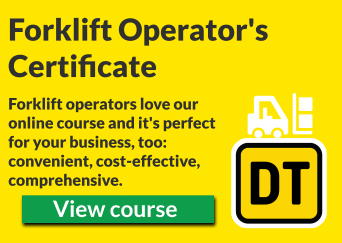If you use your forklift on a road, it needs to be registered, but the definition of ‘road’ is very broad. It includes places that the public has access, whether by right or not. This allows police and other authorities to create rules about the use of motor vehicles, even where the public may not necessarily expect to find them, such as a beach or stream bed.
Certainly, if you use your forklift on a public road (i.e. part of the road network) or the footpath, it must be road-registered with a current warrant of fitness. The driver must have an F endorsement on their driver’s licence. But your yard could also be considered a road. How do you tell? Courts do apply a number of principles when considering if a place is a road:
- Do the general public have access to your yard, i.e. can anyone walk off the street to visit for the purposes of doing business with you and they would be typically unsupervised. For example, a hardware store’s yard would fall into this category as you would reasonably expect a person could browse around to pick the materials they require.
- If your yard is open, do the public actually use it? A yard might be accessible to the public, but the presence of gates, warning signs, painted walkways and other controls may mean that courts could consider it an area that is not a road, especially if there’s no reason for them to be there. For example, a hazard board with instructions to report to reception and wear hi-vis clothing would mean that a member of the public would not reasonably be expected to walk directly into the yard without registering their presence and being accompanied by another staff member.
The problem is that no concrete rules exist for this – the courts decide on a case-by-case basis and are likely to take other factors into consideration such as your health and safety policies, training, induction, the condition of your plant, how an incident happened, etc. WorkSafe publishes a Workplace Traffic Management fact sheet that outlines the safe site, safe vehicle, safe driver system.
If you operate within a right-of-way and there are other businesses further down the right-of-way, this could be considered a road, even if your company has controls. All businesses down the right-of-way would need to agree to a unified plan to manage forklift operations and ensure that warning signage and gates were present. If any one company in the right-of-way allowed general public access, it could be difficult to justify that it’s not a ‘road’. If there is public parking within an area that forklifts operate, again, it sounds like a road. We suggest that you get advice from WorkSafe and/or NZTA if you operate in any of these scenarios.
If you are confident that your operators do not operate your forklifts on a road, then you can have them do the forklift operator’s certificate course every three years or less. If they do drive on the road then they should take an F endorsement + operator’s certificate course first, then do operator’s certificate courses every three years after that.
Disclaimer: this article is not legal advice. We suggest you investigate your options and obligations for your own scenario.


